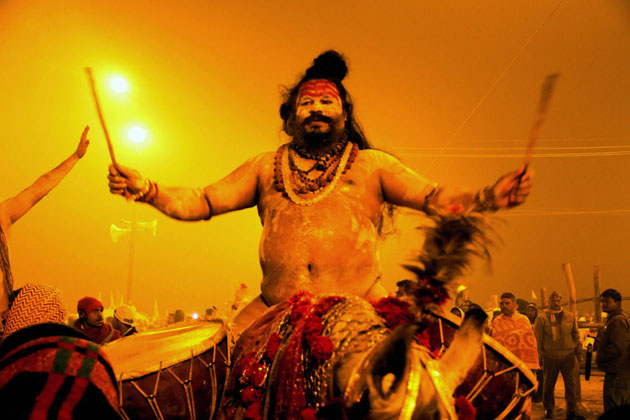Every 12 years Hindu pilgrims gather at the confluence of the Ganges and Yamuna rivers in northern India to bathe in the sacred waters. The gathering, known as the Kumbh Mela, is the world’s largest religious festival, drawing millions of people over 55 days, and culminating this year with the Shivaratri Snan bathing day on March 10. To accommodate everyone, the Indian government creates a temporary city-building roads and providing power on what is normally an empty flood plain. Senior Lecturer and Dauten Real Estate Fellow John Macomber, a member of the School’s Finance Unit, visited the Kumbh in January to discover what such an undertaking can teach us about real estate, urbanization, sustainability, and infrastructure.
In addition to the video and Q&A below, Macomber has written a first-person account about his journey for Harvard Business School Working Knowledge, Why a Harvard Finance Instructor Went to the Kumbh Mela.
Jim Aisner: What are the most important lessons you learned from your trip to India?
John Macomber: I learned things on a personal level as well as lessons relevant to my interests in finance and planning in the field of urban development. From a personal point of view, it was remarkable to see tens of millions of people from all walks of life, rich and poor, gather together in what was literally a pop-up city and go about their daily and religious lives, inhabiting tents of one kind or another, traveling on specially constructed roads, using the electrical power and illumination generated from 22,000 temporary light poles, and making their religious commitments as they bathed in the Ganges and Yamuna Rivers over the course of the day, many beginning in the darkness before dawn.
From a research point of view, I learned quite a bit in the context of my work looking at new cities all over the world. I’m interested in rapid urbanization. At the Kumbh Mela, you have the clearest example I know of the creation of a huge and totally new city from scratch. This land, after all, was under water six months ago—the entire four-by-eight-kilometer area—and it’s going to be under water again in six months, since it’s in the flood plain of the two rivers.
Cities consist of many components—people, buildings, roads, schools, bridges, water, power plants, transit, security, health care—and I was interested to see what would be the focus of administrative attention during the festival. Tens of millions of people all around the world are moving into cities from the countryside looking for opportunities, but in doing so they encounter a scarcity of resources—not enough clean air or fresh water, not enough places to put the garbage, for instance. All these considerations resonate in India, where it’s estimated that some 400 million people are moving into urban areas. They all can’t go to Mumbai and Calcutta. They will have to go to new cities. Might there be best practices to extend from this new city?
And then there’s the role of government in the urbanization process. There’s always the hope that government can wave a magic wand and fix these problems, but generally government can’t. It is either paralyzed by politics or a lack of money. So the private sector has the obligation, and more important to my work, the opportunity, to get engaged. At the Kumbh Mela there was a central administration for the festival, much as there would be for a big state fair in the United States. It worked in coordination with the smaller religious groups as well as the seventeen big religious organizations involved, the Akharas, which each ran whatever happened in their area—all the activities, all the housing, all the building, most of the food, a lot of the sanitation. As a result, there was an interesting public-private coordination to look at.
Q: How will HBS students benefit from your trip and observations?
A: We are writing a case about the Kumbh Mela focusing on finance and strategy. An A case will be largely descriptive about what we saw on this trip. It will be followed by a B case set at the next festival, which will take place twelve years from now. There are a number of interesting pedagogical things you can do by looking out that far.
When you start with a blank page more than a decade hence, you need to analyze how the next Allahabad Kumbh Mela city will be laid out. Will all of the elements be in the same or different locations, depending on the new channels and the new banks the rivers provide. What will be the sanitary condition of the Ganges? What will India and the world look like economically, politically, and in terms of electricity and water in twelve years? We can put students in the position of the lead administrator and talk about constrained resources and the need to make some choices.
For example, the temporary steel-plate-on-sand roads we saw were made very wide to accommodate and help organize the pilgrims. How will you handle it the next time? Are you going to let the religious groups have all the acreage they ask for and make the roads smaller as a result? Or will you restrict the religious groups’ acreage and make the roads even wider to control foot traffic—and land disputes-even more? What about expanding the festival site northward, thereby creating the equivalent of urban sprawl? Or will you encourage some “verticality” instead by constructing a number of two- or three-story buildings at an attractive site? Would commercial interests be rejected, welcomed—or even necessitated? These are all considerations that in one form or another, to one degree or another, apply to the evolution of new cities, not just the Kumbh Mela.
Q: What else makes all this relevant to an HBS student?
A: I study this event through the lens of my second-year MBA elective, Sustainable Cities: Urbanization, Infrastructure, and Finance. The relevant questions are always: What infrastructure is being built, and which people, both in and out of government, are providing it? So the teaching materials we create will use this extraordinary situation to examine the growth of a greenfield site from the perspective not only of an administrator but an entrepreneur. I always try to tie everything back to what my students can imagine themselves doing in four or five years after graduating from HBS. A few may be in a government role. More will be in the private sector as investors or entrepreneurs or managers in big companies, and they will be working all over the world in new cities.
Q: Besides you, faculty members from several other Harvard schools went to the Kumbh Mela. What can you tell us about the fruits of your collective labors now that you have all returned?
A: We’re excited about the projects underway under the umbrella of both the Harvard University South Asia Initiative and the Harvard School of Public Health’s Global Health Initiative. We all met recently to talk about what each group will produce. We are trying to incorporate and play off each other’s efforts in our own work. My HBS colleagues and I will focus on the case studies I’ve already mentioned. The School of Public Health (SPH) is conducting an examination of the first-responder facilities that dealt with the myriad medical issues that occurred over several months among the millions of people in attendance. There will also be a complex data study of cell phone traffic —telecommunications—during the festival. The Graduate School of Design has tens of thousands of images from the trip that will be accessible on their server. Also on our to-do list will be several symposia and a hardcover book delving into various aspects of the pilgrimage from the viewpoint of the different schools involved.
I plan to publish a multimedia case that will draw on material from the Divinity School’s interviews with Hindu religious leaders as to why this pilgrimage matters, along with SPH’s findings about all things health related, from the bacteria count in the Ganges to the quality of medical care. That way, the case will help students understand not only how the actual event took place but give them considerable in-depth background material about this phenomenon in a very accessible way-with frameworks and lessons that can be extended to other situations. The research and teaching prospects are fascinating. 
Video by Rebecca Byerly for Harvard Business School. Produced by Joanie Tobin/Harvard Business School. © 2013






























